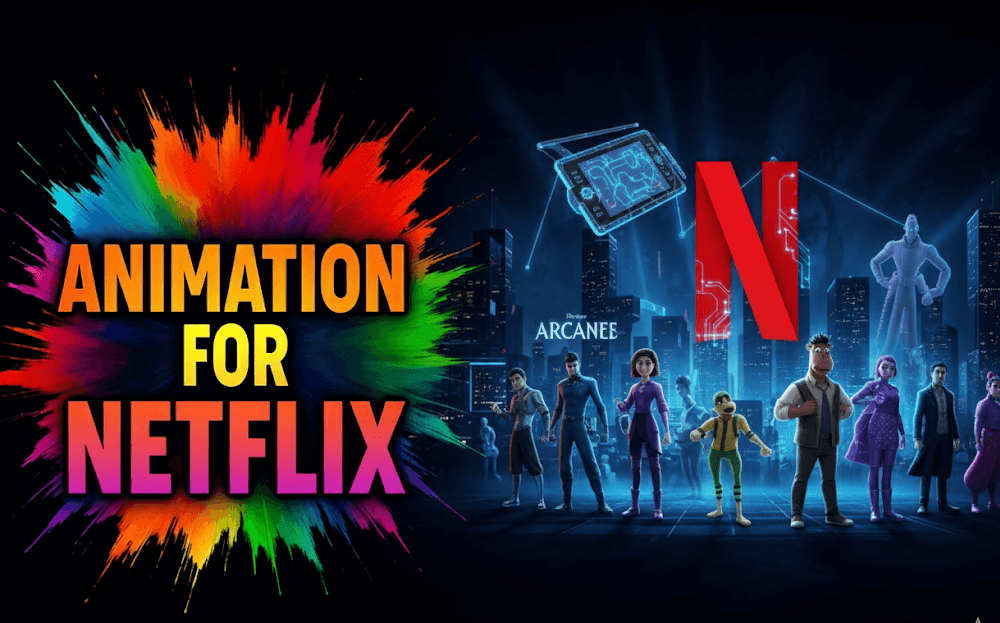Who Does Animation for Netflix? A Deep Dive into Their Strategy

Introduction
As an entertainment executive, the fragmented nature of the media supply chain is a persistent challenge. Pinpointing the exact creative and production partners behind a competitor’s breakout hit can feel like an exercise in guesswork, built on disparate data points and unverified contacts.
This opaqueness is a significant barrier to effective business development, co-production scouting, and competitive intelligence.
In this analysis, I will dissect the production strategy of one of the industry’s most influential players—Netflix—to provide a clear, data-driven understanding of who does animation for Netflix and, more importantly, how they do it.
Table of content
- Who Does Animation for Netflix? The Dual-Model Approach
- The Rise of Netflix’s In-House Animation Studios (NAS)
- Global Partnerships: Fueling Netflix’s Animation Supply Chain
- The Strategic Implications of the Netflix Animation Model
- How Vitrina Helps De-Risk the Animation Supply Chain
- Conclusion
- Frequently Asked Questions
Key Takeaways
| Core Challenge | The animation production landscape is highly fragmented, making it difficult to identify the full scope of a major player’s creative partners and their strategic direction. |
| Strategic Solution | Netflix employs a dual-model strategy, combining a growing in-house studio with a vast network of global external production partners to drive diversity and scale. |
| Vitrina’s Role | Vitrina provides a centralized, data-rich platform that maps the entire entertainment supply chain, enabling executives to identify every company, project, and collaborator behind Netflix’s animated titles. |
Who Does Animation for Netflix? The Dual-Model Approach
To truly understand who does animation for Netflix, one must look beyond a simple list of names and recognize a sophisticated, two-part strategy. Unlike legacy media conglomerates that historically rely on a single, dominant internal studio (e.g., Walt Disney Animation Studios or Pixar), Netflix has built a hybrid model that maximizes both creative control and global reach.
This strategy is driven by a desire to produce a vast volume of content that caters to diverse audiences, from family-friendly features to edgy adult series.
This dual approach consists of:
- In-House Production: The development of Netflix Animation Studios (NAS) as a primary engine for original, high-quality animated films and series. This allows Netflix to maintain direct creative oversight and build a core artistic identity.
- External Partnerships: A robust ecosystem of co-production and licensing deals with hundreds of independent animation studios worldwide. This model provides unprecedented flexibility, enabling Netflix to tap into specialized talent and cultural nuances for genres like anime and foreign-language titles.
This hybrid model is a direct response to the global streaming wars. As of the fourth quarter of 2024, Netflix had over 300 million paid subscribers worldwide (Source: Statista). To service such a vast and varied audience, a single animation style or production pipeline is simply insufficient.
By strategically leveraging both internal and external resources, Netflix can rapidly scale its content slate and respond to regional demand in key growth markets like Asia-Pacific and Latin America, where animation consumption is particularly high (Source: TVREV).
For an executive navigating this complex landscape, the challenge is not just knowing that these partnerships exist but understanding their specific nature, their track record, and the key creative leaders involved. The decentralized nature of this strategy creates a significant information gap for those who rely on manual research and fragmented news sources.
Who Does Animation for Netflix? The Rise of Netflix’s In-House Studios (NAS)
At the heart of Netflix’s in-house efforts is Netflix Animation Studios (NAS), a full-pipeline operation with three primary hubs in Burbank, California; Vancouver, British Columbia; and Sydney, Australia (Source: Netflix Animation).
The establishment of this internal capacity was a strategic move to secure a consistent output of animated feature films and series, bypassing the traditional studio-to-studio acquisition model.
A pivotal moment in this strategy was the acquisition of the Australian animation studio Animal Logic in 2022, which now operates as a core part of NAS, strengthening their capabilities in CG animation.
NAS titles often receive significant marketing pushes and have garnered critical acclaim and awards. For example, Guillermo del Toro’s Pinocchio was an in-house production that went on to win the Academy Award for Best Animated Feature Film. Other notable titles include Over the Moon, The Sea Beast, and My Father’s Dragon.
From an executive perspective, the existence of an in-house studio signifies Netflix’s long-term commitment to the genre. It’s not just a content play but a move to control the entire production value chain, from ideation to final delivery. This provides a stable, predictable pipeline of content that complements the more agile, project-based external partnerships.
Who Does Animation for Netflix? Global Partnerships & the Supply Chain
While NAS handles a portion of the slate, the vast majority of Netflix’s animated titles are the result of co-productions, acquisitions, and deals with a sprawling network of external studios.
This is where Netflix’s strategy truly differentiates itself, allowing for a level of diversity that would be impossible with an in-house-only model. These partnerships span continents and genres, each one a critical node in the global M&E supply chain.
Major Studio Collaborations
Netflix has secured multi-project deals with major industry players. A prime example is their partnership with Sony Pictures Animation, which has yielded hits like the Academy Award-nominated The Mitchells vs. the Machines and Wish Dragon. The ongoing relationship with Aardman Animations, the British studio behind Wallace & Gromit, further illustrates this model, resulting in projects like Robin Robin and the upcoming Wallace & Gromit: Vengeance Most Fowl (Source: about.netflix.com).
The Anime Powerhouse
No discussion of Netflix’s animation strategy is complete without mentioning anime. Recognizing the immense global demand, particularly in the Asia-Pacific region, Netflix has forged production line partnerships with a number of leading Japanese and Korean studios. These collaborations have resulted in some of the platform’s most critically acclaimed and commercially successful series. Key partners include:
- MAPPA: The studio behind Dorohedoro.
- Studio Mir: The Korean studio that produced the hit series The Witcher: Nightmare of the Wolf.
- Production I.G: A partner on projects like Ghost in the Shell: SAC_2045.
This strategic focus on localized content is a key differentiator. It allows Netflix to attract and retain subscribers in markets where anime is a mainstream art form, proving that their approach is about more than just global dominance—it’s about hyper-local relevance.
The Strategic Implications of the Netflix Animation Model
For a business development or co-production executive, understanding Netflix’s dual-model strategy has several key implications:
- Market Saturation & Opportunity: While the market is increasingly crowded, the sheer volume of Netflix’s output creates opportunities. For every internal project, there are dozens of external productions that require services, financing, or distribution. The challenge is identifying who is working on what, at which stage of production.
- The Rise of Adult & Non-Theatrical Animation: Netflix has used its platform to champion “prestige animation” for adult audiences, a lane traditionally overlooked by legacy studios. Series like Love, Death & Robots and Blue Eye Samurai showcase a willingness to experiment with diverse styles and mature themes, providing a blueprint for how to use animation to capture new demographics (Source: Collider).
- Data as a Differentiator: While specific consumption data isn’t public, Netflix uses its internal analytics to inform its commissioning strategy. This data-driven approach allows them to identify successful genres and art styles, then commission content from studios that specialize in those areas. This is why you see a continued investment in specific types of anime or CGI productions.
The core strategic challenge for any industry stakeholder remains the same: how to gain a complete, actionable view of this complex, ever-shifting ecosystem. Traditional methods of market intelligence—reading trade publications, attending festivals, and relying on personal networks—are no longer sufficient to keep pace with a company operating at this scale.
How Vitrina Helps De-Risk the Animation Supply Chain
In a world where Netflix’s animation strategy is both in-house and globally outsourced, a tool that can provide a single source of truth is invaluable. Vitrina is purpose-built to address this fragmentation.
The platform’s proprietary Project Tracker allows you to trace a project’s full journey, from its initial development stage to its final release. This means you can identify not only the primary studios behind a series like Arcane or a film like Nimona, but also the key creative executives, co-producers, and vendors involved in every stage. By mapping these collaboration networks,
Vitrina provides a level of competitive intelligence and business development insight that is simply unattainable through manual research. For a co-production executive, this means quickly identifying potential partners with a proven track record. For a vendor, it means pinpointing projects early in their lifecycle to build a business pipeline.
Conclusion
Netflix’s animation strategy is a masterclass in modern, data-informed content creation. By skillfully balancing a growing in-house studio with an expansive global network of partners, they have created a model that is both scalable and incredibly diverse.
For executives in the M&E supply chain, understanding this dynamic is essential for strategic decision-making and deal-making. With the right market intelligence platform, you can move from guesswork to precision, turning this fragmented landscape into a source of competitive advantage.
Ready to transform your strategic scouting and business development? Sign-up Today
Frequently Asked Questions
Yes, Netflix has an in-house studio called Netflix Animation Studios (NAS). It has production hubs in Burbank, California; Vancouver, British Columbia; and Sydney, Australia. While it produces a significant amount of content, Netflix also works with a vast network of external partners.
Netflix has production partnerships with several leading Japanese and Korean animation studios to create original anime content. These partners include MAPPA, Studio Mir, Production I.G, Bones, and David Production, among others.
Netflix produces a wide range of animated content, including films and series. Notable titles from its in-house or co-production slate include The Sea Beast, Pinocchio, Arcane, Blue Eye Samurai, and The Mitchells vs. the Machines.
Netflix’s careers page describes its animation studio as a full-pipeline operation that values creativity and talent. They have a global presence and hire a variety of artists, production professionals, and technical staff. Specific employment experiences can vary widely depending on the role and project.

























